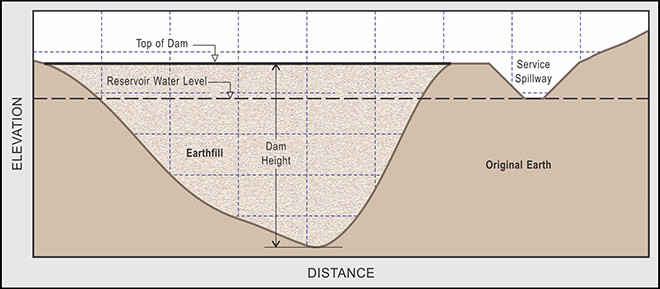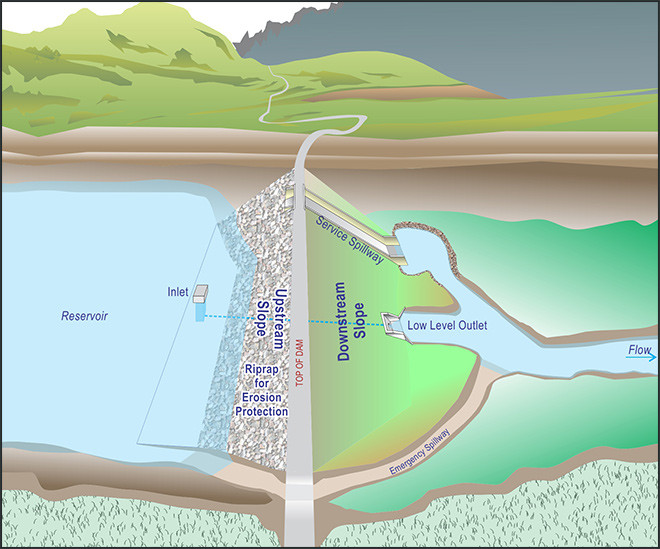Government mail service may be affected by the Canada Post labour disruption. Learn about how critical government mail will be handled.
Overview
Dams are located throughout Alberta and vary in size. They are constructed as single or multi-purpose structures for the following:
- fishing and recreation
- flood control
- hydropower development
- industry
- irrigation and agriculture, including livestock watering
- municipal/household water supply
- tailings containment
- wastewater containment, including sewage lagoons
Dams can be located either on-stream or off-stream. In Alberta, on-stream dams have been constructed on most major rivers and tributaries to store spring runoff. The storage reservoirs created by these dams provide water year-round for the various uses mentioned above. Most have become multi-use facilities and serve as the cornerstone in the development and management of water resources in Alberta's river basins.
River flows in Alberta are variable year-round as they are primarily fed by glacial and/or snowmelt in the spring and precipitation during the remainder of the year. Highest flows typically arrive in the spring, allowing reservoirs to be filled before the dry summer months when water demands reach their peak.
Off-stream dams are typically used to collect storm water, hold mining tailings, or as sewage lagoons or industrial water supply and storage.
Dams pose risks and consequences, especially in the case of a breach or failure; therefore, it is important to understand what a dam is, where they are located and who is responsible for their safety.
What is a dam?
A dam is a barrier constructed for the purpose of storing water, including water containing any other substance such as the tailings from mining projects. Dams can be constructed from a variety of materials including earth, concrete, timber and metal.
Earthfill dams
While each dam is unique in how it is designed and constructed, most dams in Alberta are earthfill dams. These dams are constructed using one or more types of suitable soils to accommodate a variety of factors including the local geology and geography, and the purpose, size and risk associated with the dam. The following diagrams show a cross section and profile of a simple earthfill dam.


Dams have 3 visible faces:
- upstream slope (the face of the dam facing the reservoir/pond)
- downstream slope (the face of the dam facing away from the reservoir/pond)
- crest (the top of the dam, which is often used as the foundation for a road)
To protect the dam from erosion these surfaces can be covered with a variety of materials such as rock, vegetation, concrete and asphalt. A typical dam will have rock armour (known as rip-rap) on the upstream slope, grassy vegetation on the downstream slope, and asphalt or gravel on the crest.
Appurtenant structures
Dams have other structures associated with them to regulate water levels and prevent a dam failure. These associated structures are known as appurtenant structures. Together, the dam and its appurtenant structures form a dam project. The basic components of a dam project include:
- dam
- outlet works
- spillways (service spillway, emergency spillway)
- low level outlet
- reservoir
- downstream channel
The images below show 2 examples of dam projects.


Outlet works
Outlet works are a combination of structures used to release and/or regulate the release of stored water from the reservoir created by the dam. These structures can include pipes, gates, tunnels, chutes and spillways of various shapes, sizes and design.
Spillways
Spillways are the most important appurtenant structures. They are used to release excess water from the reservoir to ensure water does not overtop the dam and cause a potential failure due to excessive erosion. Spillways vary in size and shape depending on capacity and function. There are two types of spillways based on their function: service and emergency.
Service spillways
Service spillways are permanent, non-erodible structures that are used during regular operations to control the release of water from the reservoir. They are particularly useful during major rainfall and other inflow events to ensure reservoir water levels are maintained at a safe elevation.
Most large dams use a gated concrete chute service spillway to enable greater control over the storage and release of water. Other dams use un-gated spillways to help maintain safe water levels without the need for mechanical operation and maintenance, unlike a gated spillway.
Emergency spillway
Emergency spillways, like service spillways, are also used to release excess water to prevent water from overtopping the dam. However, emergency spillways only operate in extreme situations when the water level in the reservoir exceeds a predetermined maximum flood level and the safety of the dam becomes threatened.
Low level outlet
The low level outlet is typically a conduit located near the bottom of the dam and is used to maintain riparian flows downstream of the dam and if required, to empty the reservoir. The maximum flows that can be released through a low level outlet are much less than what can be passed over a spillway. Like spillways, the size and type of low level outlets vary depending on the capacity and function.